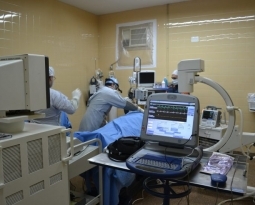Nebraska Patent of the Month – February 2024
The medical industry has seen rapid growth and investment in robot-based procedures. Virtual Incision Corporation has been pushing boundaries in this new industry, working to make every operating room robot-ready. This system marks a significant leap forward in minimally invasive surgical procedures, addressing limitations posed by traditional methods.
At the heart of Virtual Incision’s invention lies a meticulously designed robotic surgical device. The device is made of an elongated body with first and second shoulder joints, each connected to segmented robotic arms. What sets this system apart is the inclusion of a sophisticated camera lumen, a key component enhancing visualization during surgeries.
The camera lumen comprises a socket at the proximal end, housing a removable camera component. This component, with a controller body and an elongated tube, can be seamlessly inserted into the device. The camera’s design includes a tiltable optical section, providing flexibility for optimal viewing angles within the patient’s body.
Virtual Incision’s invention addresses the need for enhanced mobility and visual feedback in minimally invasive procedures. The first and second shoulder joints, along with the segmented robotic arms, allow for precise movement and manipulation within the surgical field. The system’s versatility is further amplified by the inclusion of a removable camera component, facilitating adaptability to various surgical scenarios.
A noteworthy feature is the seal structure within the camera lumen, ensuring a secure and fluidic connection while minimizing the risk of contamination. The removable nature of the seal structure adds a layer of convenience to the system.
The controller body of the camera component is equipped with actuators, enabling pan and tilt functions. This dynamic control enhances the surgeon’s ability to navigate and visualize the operative site with unparalleled precision.
Virtual Incision’s dedication to user-friendly design is evident in the handle controller body, featuring a button for easy unlocking. The system’s thoughtfully engineered details, such as the inclusion of a ring-seal retention component, showcase the meticulous attention Virtual Incision has invested in ensuring reliability and efficiency.
The company’s technology is being marketed as MIRA – the world’s first miniaturized Robotic-Assisted Surgery system. The system is incredibly portable with a convenient and compact form factor. This means the system can be set up in an operating room in minutes.
Are you developing new technology for an existing application? Did you know your development work could be eligible for the R&D Tax Credit and you can receive up to 14% back on your expenses? Even if your development isn’t successful your work may still qualify for R&D credits (i.e. you don’t need to have a patent to qualify). To find out more, please contact a Swanson Reed R&D Specialist today or check out our free online eligibility test.
Who We Are:
Swanson Reed is one of the U.S.’ largest Specialist R&D tax advisory firms. We manage all facets of the R&D tax credit program, from claim preparation and audit compliance to claim disputes.
Swanson Reed regularly hosts free webinars and provides free IRS CE and CPE credits for CPAs. For more information please visit us at www.swansonreed.com/webinars or contact your usual Swanson Reed representative.

















